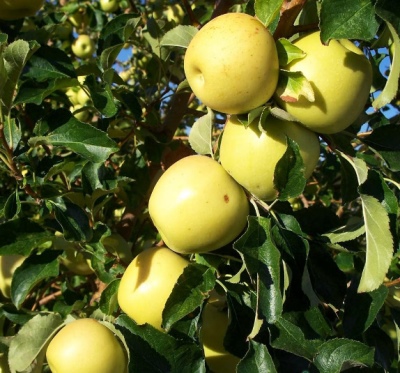
- Authors: Leningrad Fruit and Vegetable Experimental Station (LPOOS), P.I. Lavrik, L.A. Zhmurko
- Taste: sweet and sour
- Fruit weight, g: 140
- Fruit size: large
- Yield: at the age of 15 years harvest - 45 kg, maximum - 60 kg
- The beginning of fruiting varieties: for 5-6 years
- Ripening terms: late summer
- Removable maturity: late August - early September
- Keeping quality: up to 60-70 days
- Appointment: fresh
Apple tree Memory Lavrik is a variety that is ideal for the harsh winters in our country. It does not require special care for itself and can please with stable fruiting.
Breeding history of the variety
The Leningrad Fruit and Vegetable Experimental Station became a producer of the described variety, which appeared when Papirovka and Bellefleur Chinese were crossed.
Description of the variety
The maximum tree height is 4 meters. The branches form a rounded, dense crown that requires annual pruning.
Features, pros and cons
Of the features of this variety, the following positive qualities can be distinguished:
excellent resistance to cold;
there is immunity to scab;
the harvest will delight you with its stability.
Of the shortcomings, only the late start of fruiting can be distinguished.
Ripening and fruiting
Lavrik's memory refers to late summer varieties with maturity, which occurs by the end of summer, beginning of autumn. The gardener begins to collect fruits only 5-6 years after planting the seedlings.
Growing regions
In all regions of our country, you can find an apple tree of the described variety.
Yield
When a tree reaches 15 years old, it can bear up to 45 kg of apples, with good care this figure can increase to 60 kg.
Fruits and their taste
The fruits of Lavrik's Memory are suitable only for fresh consumption. Apples have an attractive pale yellow skin that is quite thick and waxy on the surface.
The shape of the fruits of the described apple tree is elongated, conical. One apple can weigh up to 140 grams. Like most apples, Memory of Lavrik tastes sweet and sour. The pulp is very juicy.
After picking from the tree, apples will stay for up to 70 days, if you provide them with the proper conditions.

Growing features
The described variety grows mainly on two types of soil:
loam;
podzolic soil.
The tree is very fond of the sun and does not like the accumulation of water in the ground. It is imperative to keep a distance of 1.5-2 meters between plants.
It is important to do the pruning on time. An apple tree in this class should be slightly conical in shape, with more volume at the base than at the top. It is this option that allows sunlight to reach the maximum number of branches.
The correct solution would be to leave one center frame. Depending on the size of the tree, it should have 2 to 6 main branches, the rest should be removed. The angle of inclination of the branches is very important. Those that are left are angled to the central trunk from 45 to 50 degrees. If it is less, then the branch may break over time under the weight of the fruit. If the angle is greater, then the tree will not bear the required amount of fruit.
Unwanted shoots that grow at the base of the trunk are removed completely. This is the only part of the tree that can be pruned towards late summer and early fall. All dead, diseased or damaged shoots are also removed.



Pollination
Apple trees of varieties that bloom at the same time as Lavrik's Memory are used as a pollinator. Bees will be good helpers, but in order for them to cope with the task, you will have to buy several hives or rent them.
Professionals find a different way out of the situation - they vaccinate a different variety on an apple tree.
Top dressing
It is advised to feed the plant for the second and subsequent years. If there are signs of a lack of one or another mineral element, complex mixtures are introduced into the soil with a slow release of minerals.
You should definitely use nitrogen, wood ash works well. Potassium, calcium and zinc play an important role in the formation of large and beautiful fruits. To understand at what level all the necessary elements are present in the soil, you will need to conduct a soil test.
You can not flirt with fertilizers - if the apple tree Memory Lavrik gets an overdose, for example, boron, then its fruits cannot be eaten due to their toxicity.

Frost resistance
The described variety has excellent resistance to frost and spring frosts.

Diseases and pests
Despite the fact that this apple variety has good scab resistance, preventive treatment against insects will have to be carried out. To do this, use neem oil, an infusion of garlic, which is sprayed onto the tree at the beginning of the growing season.
As for powdery mildew, it is easy to deal with it: it is enough to cut off infected branches and twigs at the beginning of the season. If the disease is severe, fungicides can be used for treatment.
The situation is more complicated with late blight, which cannot be controlled. There is no cure for the disease, which makes prevention extremely important. Preventive control includes the use of bactericides and insecticides.Experts recommend applying a copper fungicide spray just before flowering.

The apple tree is a popular fruit crop among gardeners. It can be found in many summer cottages. But at the same time, such trees are often affected by various diseases. It is very important to recognize the disease in time and carry out the necessary procedures for a speedy recovery. Otherwise, the fruits will be spoiled, and the tree itself may die altogether.












































































